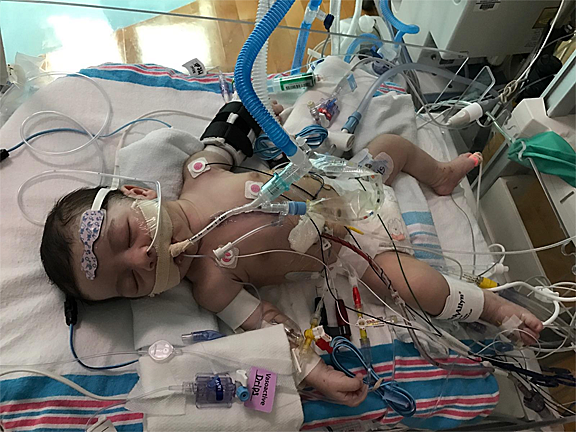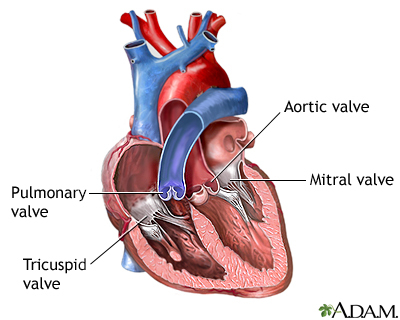Cribside Critical Care
Monitoring our tiniest patients within hospital walls and beyond. David “Jackson” Rodes was born on April 8 to Ashley DuBois and David Rodes of Tallahassee.…

Update your location to show providers, locations, and services closest to you.
Pulmonic stenosis is a heart valve disorder that involves the pulmonary valve.
This is the valve separating the right ventricle (one of the chambers in the heart) and the pulmonary artery. The pulmonary artery carries oxygen-poor blood to the lungs.
Stenosis, or narrowing, occurs when the valve cannot open wide enough. As a result, less blood flows to the lungs.
Valvular pulmonary stenosis; Heart valve pulmonary stenosis; Pulmonary stenosis; Stenosis - pulmonary valve; Balloon valvuloplasty - pulmonary
Narrowing of the pulmonary valve is most often present at birth (congenital). It is caused by a problem that occurs as the baby develops in the womb before birth. The cause is unknown, but genes may play a role.
Narrowing that occurs in the valve itself is called valvular pulmonic stenosis. There may also be narrowing just before or after the valve.
The defect may occur alone or with other heart defects that are present at birth. The condition can be mild or severe.
Pulmonic stenosis is a rare disorder. In some cases, the problem runs in families.
Many cases of pulmonic stenosis are mild and do not cause symptoms. The problem is most often found in infants when a heart murmur is heard during a routine heart exam.
When the valve narrowing (stenosis) is moderate to severe, the symptoms include:
Symptoms may get worse with exercise or activity.
The health care provider may hear a heart murmur when listening to the heart using a stethoscope. Murmurs are blowing, whooshing, or rasping sounds heard during a heartbeat.
Tests used to diagnose pulmonary stenosis may include:
The provider will grade the severity of the valve stenosis to plan treatment.
Sometimes, treatment may not be needed if the disorder is mild.
When there are also other heart defects, medicines may be used to:
Percutaneous balloon pulmonary dilation (valvuloplasty) may be performed when no other heart defects are present.
Some people may need heart surgery to repair or replace the pulmonary valve. The new valve can be made from different materials. If the valve cannot be repaired or replaced, other procedures may be needed.
People with mild disease rarely get worse. However, those with moderate to severe disease will get worse. The outcome is often very good when surgery or balloon dilation is successful. Other congenital heart defects may be a factor in the outlook.
Most often, the new valves can last for decades. However, some will wear out and need to be replaced.
Complications may include:
Contact your provider if:

Carabello BA. Valvular heart disease. In: Goldman L, Schafer AI, eds. Goldman-Cecil Medicine. 26th ed. Philadelphia, PA: Elsevier; 2020:chap 66.
Heaton J, Kyriakopoulos C. Pulmonic stenosis. In: StatPearls [Internet]. Treasure Island, FL: StatPearls Publishing; 2022 Jan-. Updated May 8, 2022. www.ncbi.nlm.nih.gov/books/NBK560750/.
Pellikka PA, Nkomo VT. Tricuspid, pulmonic, and multivalvular disease In: Libby, P, Bonow RO, Mann DL, Tomaselli, GF, Bhatt DL, Solomon SD. Braunwald's Heart Disease: A Textbook of Cardiovascular Medicine. 12th ed. Philadelphia, PA: Elsevier; 2022:chap 77.
Therrien J, Marelli AJ. Congenital heart disease in adults. In: Goldman L, Schafer AI, eds. Goldman-Cecil Medicine. 26th ed. Philadelphia, PA: Elsevier; 2020:chap 61.
Valente AM, Dorfman AL, Babu-Narayan SV, Krieger EV. Congenital heart disease in the adolescent and adult. In: Libby, P, Bonow RO, Mann DL, Tomaselli, GF, Bhatt DL, Solomon SD. Braunwald's Heart Disease: A Textbook of Cardiovascular Medicine. 12th ed. Philadelphia, PA: Elsevier; 2022:chap 82.


Monitoring our tiniest patients within hospital walls and beyond. David “Jackson” Rodes was born on April 8 to Ashley DuBois and David Rodes of Tallahassee.…
